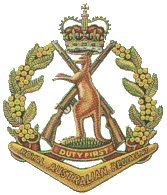
6 RAR -The Sixth Battalion of the
Royal Australian Regiment(RAR)
Battalion Operations
 |
6 RAR -The Sixth Battalion of the Royal Australian Regiment(RAR) Battalion Operations
|
The major Battalion Operations are described elsewhere in this record. There are many
other minor operations that also are worthy of mention. These were:
Operation BRISBANE - 16th - 18th July, 1966.
Intelligence indicated that an enemy force of about battalion strength and possibly part of a North Vietnamese Regiment was located in the valley between the two hill masses, Nui Dinh and Nui Thi Vai, west of the Task Force Base.
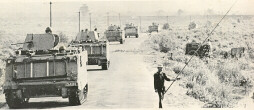 |
The Battalion deployed, using 38 carriers of the Ist APC Squadron, to sweep and destroy in the reported area of enemy movement. |
Nothing was located; however further experience was gained in control, deployment, navigation and movement in close country.
Operation CASULA-25th September, 1966 - end 1966.
 |
Operation Casula was initiated on 25th September, 1966 and implemented the Task Force Operational Plan to construct and improve defensive works in the base area. It was exremely important after the Task Force deployment to Nui Dat to ensure that a defensive positions were established. After the Battle of Long Tan this was a priority task for units in the Task Force area. |
Operation BATHURST - 20th - 27th October, 1966.
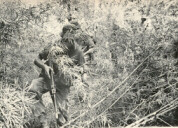 |
In this period the Sixth Battalion conducted saturation patrolling of the Tactical Area of Responsibility with armoured, artillery and tactical air support. TAOR patrols were agressively conducted by the Task Force Units. |
Operation BUNDABERG-30th - 3 Ist October, 1966.
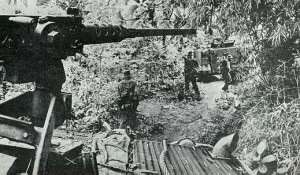 |
This was a village cordon and search operation, of Hoa Long village, the troops being in their cordon position before first light. |
This operation was under Task
Force Command and included, besides all combat units of the Task Force, a South Vietnamese
battalion, district troops and National Police, to successfully cordon and search the
village. Included in the operation were medical teams, dental teams and civil
affairs support.
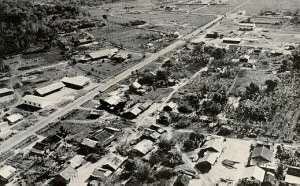 |
Hoa Long is a village about 2000 metres to the south of the Task Force, with a population of 4000. The hamlet is surrounded by an earth embankment from 3-6 feet in height, forward of which is a ditch. The village lay surrounded by flat rice paddy grass land and fruit plantations. |
Until May, 1966, the village was VC dominated, but with the arrival of the Task Force and
the Civic Action programme, many hearts and minds had been won over to the Government
cause. Nevertheless there was still a hard core of pro-communists and VC local guerillas
living in or constantly visiting the village.
The cordon was successful. for there were 630 detainees of which 38 were identified as
Viet Cong PWs, 41 were suspect VC and 18 were draft dodgers from the Vietnamese Army.
Operation WOLLONGONG-8th January, 1967 - 21st March, 1967.
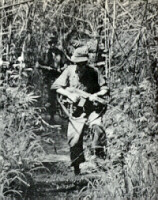 |
This code name encompassed all the close patrolling in the Tactical Area of Responsibility for the Battalion, whether Battalion, Platoon or Company sized patrols. In conjunction with this patrolling went the development of the base area, particularly messing and canteen facilities. |
Operation CAMDEN - 16th -
17th January, 1967.
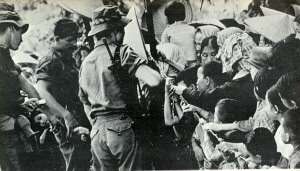 |
Though the subject of an intensified program of civic action, since the establishment of the Task Force in June, 1966, in January 1967 Hoa Long still had Viet Cong elements covertly active. |
Shots had been fired at Task
Force vehicles, meetings had been held, propaganda leaflets handed out and acts of murder
and terrorism had been perpetrated.
These thorns in the side of our pacification and re-settlement program were not wholly
jeopardising the program, but were irritating to the extent that it became necessary to
cordon and search the village for a second time. The Sixth Battalion was responsible for
the cordon and search of the south-western side of the village and on 17th January the
cordon troops moved into their positions under cover of darkness.
A detailed search of the area and the dwellings was conducted during daylight hours on 17th January. Of note, one villager was caught by A Company, while he was attempting to escape before first light. He was later identified as a Viet Cong Cadre member. One member of C Company was evacuated after being attacked and injured by a belligerent water buffalo. D Company apprehended 2 detainees for interrogation. In this respect the operation was successful, if not spectacular.
Operation SEYMOUR - 28th January, 1967 - Ist February, 1967.
Operation SEYMOUR originated as a company patrol to the east and north-east of the Nui Dinh Hills in what was termed "The Gardens", a flat area of paddy and low scrub. One company from 5 RAR was also operating in the area. After 5 RAR and D Company had a series of minor contacts, the Tactical Party of Battalion Headquarters deployed, and the Commanding Officer co-ordinated the search and destroy operations of C and D Companies and the Company of 5 RAR. On the 1 st February, 1967, the force moved back to Task Force. There were no further contacts made.
Operation BEECHMONT - Sth - ]2th February, 1967.
All patrolling in the immediate vicinity of the Task Force Base that was implemented during the Vietnamese Holiday period "TET" was planned under the code name of BEECHMONT. 2 Platoon of A Company on the afternoon of the 9th February, when patrolling to the west of the Task Force, heard noise on the creek line.
 |
The platoon deployed, and observed 3 male and 2 female Viet Cong washing clothes in the stream. The Platoon surrounded the enemy and captured them, without firing one shot. The Platoon also captured 3 grenades, documents and medical supplies. |
2 Platoon of A Company on the afternoon of the 9th February, when patrolling to the west of the Task Force, heard noise on the creek line; the platoon deployed, and observed 3 male and 2 female Viet Cong washing clothes in the stream. The Platoon surrounded the enemy and captured them, without firing one shot. The Platoon also captured 3 grenades, documents and medical supplies.
Operation DALBY - 16th February, 1967.
Operation DALBY was a surprise heli-borne assault of one day's duration. After suppressive fire had been placed on the landing zones, the companies flew in and secured them, and then started to search their areas. At 0830 hours B Company contacted 2 Viet Cong, wounding one.
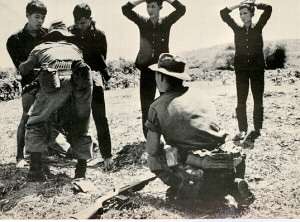 |
To C Company went 4 prisoners who had been hiding in a tunnel. Initially it was believed that there was only one suspect, but with this man appearing it was seen that there were 3 more in the hide with him. The results were 4 Viet Cong PW and 1 Viet Cong WIA. Documents, clothing, medical supplies, 60 Ibs. of rice, 1 grenade launcher, and some ammunition were also discovered. |
 |
Having made this assault on the 16th, it is of interest to remember that on the following day a heli-borne assault was launched in which the Battalion quickly deployed as a Reaction Force to prevent the withdrawal of a Viet Cong Force. |
It was this action which developed into Operation BRIBIE and in which A and B Companies experienced heavy contact with the Viet Cong on 17th February.
Operation KIRRIBILLI - 23rd - 27th February, 1967.
 |
A and C Companies patrolled to the north and northeast of the Task Force area from 23rd to 27th February, 1967. There had been recent enemy activity to the south, and thus movement to the north of our area highly probable. |
It was known that courier and resupply routes crisscrossed the area, and had been recently used.During the patrol signs were noted of recent enemy movement, in small parties of 4-5 persons; however, no large forces were contacted. A Company saw 1 Viet Cong in grey uniform, who fled north. C Company found a camp of 40 weapon pits which was destroyed.
Operation AYR - 7th March, 1967.
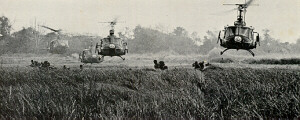 |
This operation was similar to DALBY, a heli-borne assault into a landing zone after preparatory fire by the guns. |
Notwithstanding
the insignificant results, the operation was successful for it gave the Battalion further
training in the concepts, tactics and procedures involved in an air mobile assault.
Copyright AUSVETS 1996